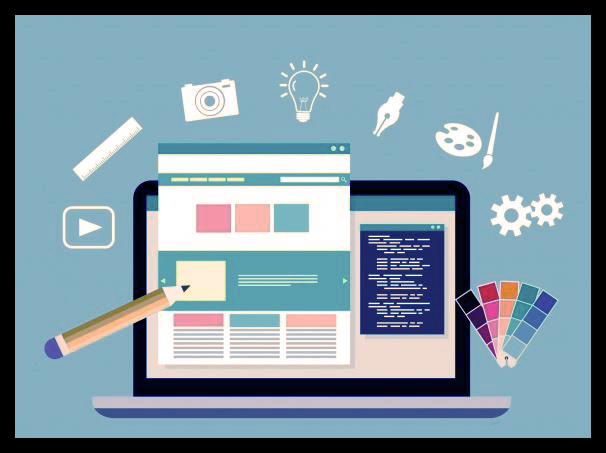Table of Contents
Where to Get Graphic Design Training Online
A career in graphic design is both exciting and lucrative. After a graphic design course and a solid portfolio, you ought to conduct income research and apply for offline and online work openings. It is important for you to evaluate consumer demand and to prepare for yourself from time to time.
Blue Sky Graphics provides a technical graphic design course for teachers, artists, artistic consultants, online marketers and anybody who wants to study graphic design. This online course is useful to acquire simple and specialised graphic design skills and techniques. You can be supported with digital content development, web marketing, branding, video creations, infographics, picture processing, and raster graphics.
Important elements which make up the graphic design
Creativity and illusion
The use of creativity and innovation are important tools, methods and skills that work not only in graphic design but also in all kinds of technology and inventions. Imagination is often a means of motivation, and learning is a source of ingenuity and imagination. You can learn how to display the current visual object, board, data, picture details, graphics, or other source with curiosity. When you see and learn the item with full focus, you can see the next potential drawing, animation, sculpture, editing, typography, advertising, templates, business card, navigation bars, website banners, and more.
Many artists are natural to the mind and create unusual artefacts. The concept of design is profound and creative. But now, we see people dreaming less and copying more, and mixing a variety of existing trends to create one concept that is nevertheless ground-breaking. And there are a host of Artificial Intelligence technologies or platforms and websites to do so, such as online icons, banners, domain templates, landing pages, pop-ups, websites, and a variety of other objects.
Courage and faith
You need to be bold and ambitious to conceive and build unique, different graphic designs. You have dismissed your latest ideas a few times. That is, either you evaluate the creativity with logic, or you are involved in other items, or you balance your designs with expert designs. In this phase, rationality wins, and creativity loses. It is crucial that the designer trusts in himself/herself and is still ready to tackle the next obstacle. Be sure you never imitate the designs of other designers, but you may still take influence from them. Be like an artist, let others assess and provide feedback.

Selling the prototypes
Sales skills are necessary in order to be a skilled graphic designer. No matter how imaginative you are, but if you are unwilling to sell your designs, ideas, and creativity, you are likely to receive a regular salary. The graphic artist continues to develop the object until the clients request it. If you grasp sales, it will help you not only explain your projects effectively, but also create products that can be easily placed on the market.

Usage with fonts, weights, and typography
Effective usage of fonts in graphics, posters, tags, flyers is an important ability in graphic design. You need to know what kind of fonts could influence and enhance the involvement of certain objects or designs.
The graphic design career entails the creation and communication of ideas or products through visual concepts, either through an online medium or by hand.
Many Graphic Designers work in communications fields to create advertisements, brochures and brand imagery, but creativity may be extended to several industries as any organisation wants to advertise a product or service. Developing a broad idea of creative communication methods is crucial to the development of this field. Learning graphic design and applications like adobe photoshop, illustrator and InDesign is not a challenging challenge thanks to Blue Sky Graphics’ online graphic design tutorial. So if you stumble with the question, ‘Where to Get Graphic Design Training Online?’ Then BSG is your answer!
What are the key responsibilities of the Graphic Designer?
The image of a brand reflects the prestige of a company. It is often the first thing that consumers see to impose a large amount of responsibility on the Graphic Artist to effectively reflect the brand that the organisation promotes.
However, a big part of the job is to decipher what the consumer needs. Clients sometimes come up with an idea in their heads, but they do not know what it is going to look like on paper (or screen).
The core responsibilities of the Graphic Designer are to make an impact on the following three primary areas:
Design of graphics
Choosing colours, images and typefaces to accurately reflect the personality of the company.
Display clients or art directors the graphic design concepts to inform them of your strategy.
Develop graphics such as icons, original images and diagrams that help to communicate the intended message to the consumer.
Design of the Internet
Use digital resources to develop graphic designers
Turn mathematical details to complex graphs and diagrams
Build fully open, interactive websites that are distinctive from conventional models.
Design of UX UI
Deliver creative thoughts by bringing significance and understanding to everything you do.
What is the technical path of a graphic designer?
There is a lot of testing going on working with others working in the artistic sector.
In order to be competitive and relevant in the business, Graphic Designers need to stay up to date with modern technologies and computer technology. Graphic design technologies are emerging and growing at a rapid pace. As a graphic designer, you do not want a company to adapt faster than your ability set.
As long as industry is concerned, the portfolio is the best junior graphic designer arm. Employers may continue to see indicators of upskilling, whether through further testing or through the study of the usage of modern graphic design programmes.
What are the qualification and preparation requirements for a graphic designer?
However, due to the heavy focus on work experience for this job, it is not established if corporations prefer applicants with a degree, certificate, diploma or a high level of functional skills. This is because the experience for this job relies on both the ability to show competence in a range of projects and an excellent portfolio of jobs.
That being said, a Graphic Design credential of some sort will only take you to better professional expectations.
Visual design is an innovative way of encouraging and communicating through the graphic portrayal of new concepts and logos to the public. It needs a talented faculty and a planner of excellent architectural and aesthetic skills. A good designer is defined by critical analysis and rational logic.
Graphic designers also strive to bind their community to promotional concepts and taglines to satisfy the desires of consumers. It is of the highest significance that the plan is forwarded to the media. Brand companies of major international organisations utilise graphic design to endorse their products.
Learn graphic design in the UK via the Blue Sky Graphics course and start your career as a graphic designer!
Graphic Production Systems
Magazines, ads and packaging are common graphic design uses. For example, a product with an emblem or other artwork, structured text and pure design elements, such as form and colour, is the job of a graphic artist. Composition is one of the fundamental aspects of graphic design, especially when utilising established equipment or materials.
The visuals and format of current text or photographs or images produced by graphic designers will be part of the design process. In a newspaper with reporters and photographers, for example, the graphic designer responsible for coordinating this system determines if any graphic features may be necessary.
Essentials in Graphic Design
In order to create an influence on the audience, the artist must often include in his idea the ounces of imagination that will help to render it an emblematic image for the viewers’ minds.
Pattern
The pattern is a series of special visual characteristics, such as a single unit or multiple types. Patterns can be used to establish continuity, organise surfaces in a consistent way, or create contrast. Examples of this include floor tiles in the retail store. Though they serve as decorations, they have a different purpose; they lead the consumer around the store.
Balance:
Balance is more about perceptual balance, our actual perception of balance. Bold or strong arrangements preserve equilibrium, symmetrically or asymmetrically, and appear to satisfy opposing forces. Symmetric compositions maintain symmetry by applying equivalent weight components and design values to each side of the theoretical middle section.
Asymmetrical equilibrium, on the other hand, utilises various weights that are typically calculated by an arbitrary line somewhere in the overall design. Asymmetric projects tend to be bolder and can bring real dramatic appeal and movement to the design.
Each feature of the design either adds or destroys the balance. Keep in mind that each element bears its visual weight, like typography, colours, photographs, proportions, textures, shapes and patterns.
Some components are bulky and capture the eye, whilst others are smaller. The way you choose to set out the elements of your design will provide a sense of harmony. Do not crowd your template by placing a tonne of heavy elements in one region of your composition, as it will throw off your balance and render your audiences feel as though their eyes are slipping off the page.



